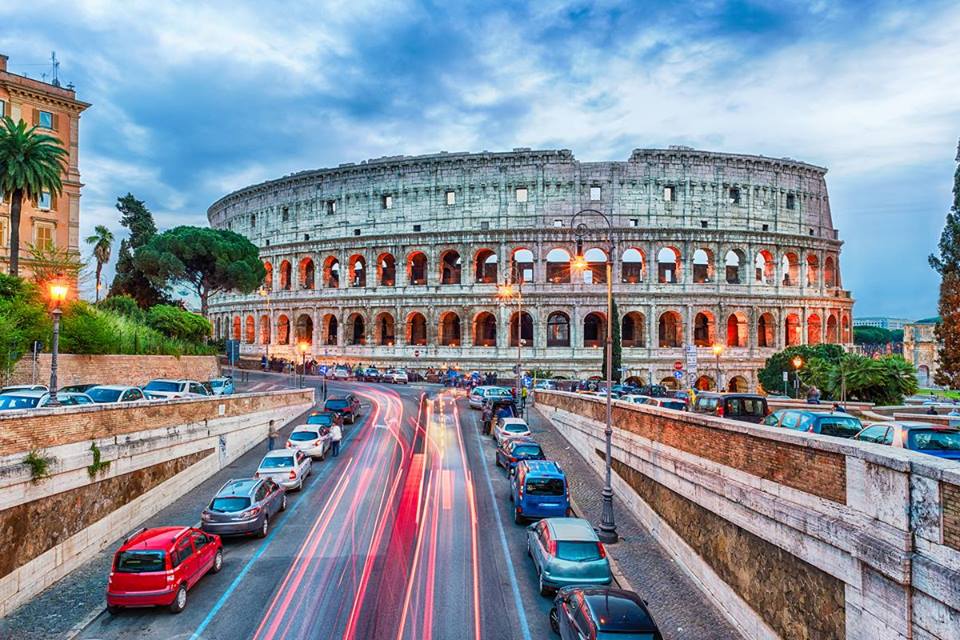The Colosseum is the symbolic monument of Rome Caput Mundi and is among the most famous in the world. Its construction began in 69 AD in the first years of the reign of the emperor Vespasian. The Colosseum, also known as the Flavian Amphitheater, was built where the artificial pond of Domus Aurea, Nero's private home, once stood.

It was inaugurated in 80 AD and the annals tell that hundreds of beasts have been sacrificed for the first few days of the festivities. The last known performance took place in 523 AD

This amphitheater it is 50 meters high and has a diameter of 118 meters. The outer ring is in travertine marble; while the overlapping tops are decorated with Tuscan-style, Ionic and Corinthian half-columns. The blind top floor is decorated with Corinthian style pilasters. Above the square windows there are brackets that supported the poles on which the velarium was fixed, which was a tent for shadowing during gladiator shows. To maneuver the velarium even the crew of sailors from the military port of Miseno was involved.
The Colosseum, gladiators arena
In the past it was possible to access the interior of the Colosseum from the arcades on the ground floor which allowed entry into the various internal sectors of the cavea, which is the space intended for spectators. Each place was marked with a number. Clearly there was the entrance of honor for the imperial tribune and other privileged accesses for the high personalities. The rich sat down, the senators were the closest to the arena and the only ones to have marble seats.

The Colosseum was built to give Rome the arena par excellence, a worthy place for the games of famous gladiators throughout the empire. Previously the duels between wild beasts and fighters are held in the temporary building built by Nero inside the Campus Martius after the old amphitheater of Tito Stanlio Tauro is devoured by a fire in 64 AD Before that, games are the great attraction of the Roman or Boario Forum.
The Colosseum, one of the most visited archaeological sites in the world
Currently, to enter the Colosseum, you pass through concentric ambulatory areas covered by barrel vaults that make up the structure on which the cavea rests. Most of the internal structure has collapsed and the stands are missing as well as the arena floor no longer exists. According to expert estimates, the Flavian Amphitheater could accommodate up to 87 thousand people, just like a large stadium of our time. The underground and the last ring of the cavea above are closed to the public for security reasons.

From the dungeons, where machinery, cages and beasts for games were kept, through a long tunnel we arrived at the Ludus Magnus or the most important of the gladiator barracks. From the last ring of the amphitheater you can enjoy a breathtaking view of the center of Rome and understand even more how majestic the work is. The Colosseum is a UNESCO heritage site and, along with the entire historic center of Rome, with over 6.5 million visitors a year, it is one of the most famous and visited archaeological sites in the world.
One of the seven wonders of the modern world
The Flavian Amphitheater was the set for many films and, in 2007, it became part of the 7 wonders of the modern world. In ancient times it was also used as a pool for naumachies, the representations of naval battles in the water. Experts have ascertained that thanks to the microclimate of the amphitheater, within the Colosseum more than 350 species of plants have taken root, some of them would also be of exotic origin.

The marble of the façade and of some parts of the Colosseum were also used for the construction of St. Peter's basilica. For a long time, in fact, the amphitheater fell into neglect and was used as a site to “sack”: a centuries-old history marked alternately by moments of brilliance and decline. Today the Colosseum is universally recognized as one of the monuments that transmit the splendor and power of ancient Rome to posterity.
(Pictures by Facebook Colosseum)





